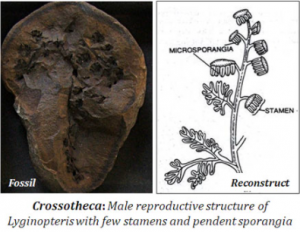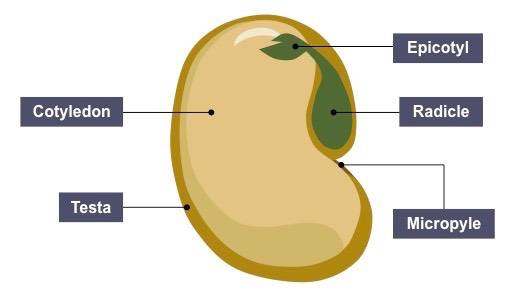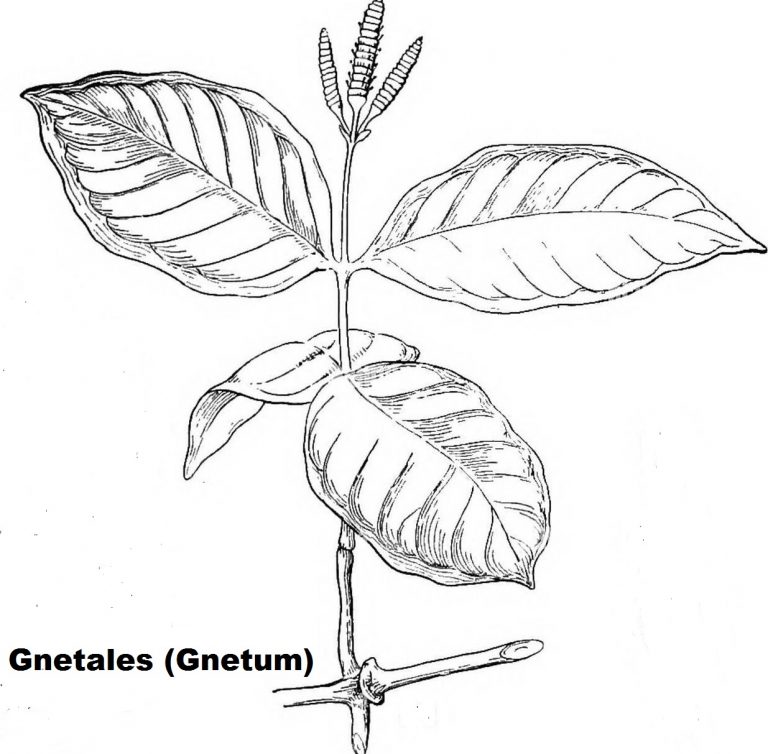Cycadofilicales \Pteridospermales: Origin, Features, Classification and Affinities
Origin of Cycadofilicales
The Cycadofilicales or Pteridosperms are popularly known as ‘seed ferns.’ This group of Gymnosperms includes trees or small plants bearing fern-like foliage. They flourished greatly in the Carboniferous period, also known as the ‘Age of Ferns.’ The plants first appeared in the Devonian, became very prominent in the Carboniferous, but remained widespread during the Permian, but a few survived even up to Mid-Jurassic. Grand Eury discovered them in 1877. The best-known Cycadofilicales were present in Great Britain.
The presence of fern-like leaves was formerly believed to be a kind of fern. Subsequently, after discovering fossil leaves with attached seeds in 1903, Oliver and Scott designated the Cycadofilicales as Pteridosperms. They are regarded as the primitive group of seed plants. Combined characters of both ferns and cycads were observed, which led to the creation of a new systematic group, the Cycadofilicales.



Characteristic Features of Cycadofilicales
- Plants were trees or small plants with monopodial branching and the presence of ramentum (rows or lines).
- Plants possessed slender stems with large frond-like leaves, as in Alethopteris & Sphenopteris.
- The primary xylem was mesarch, represented by solid or medullated protostele. Polystelic conditions were common in some members.
- The secondary wood was manoxylic (loose and soft) and limited in amount.
- The cortex was well-developed and had a longitudinally aligned fiber strand.
- Leaves were usually fern-like (frond), spirally arranged, large, and pinnately compound.
- A resistant cuticle covered the leaves.
- Young leaves are with circinate vernation.
- Ovules are borne separately along margins or on the surface of compound megasporophylls.
- Megasporophylls did not arrange to form strobili.
- Microsporophyll’s pinnately compound and not in strobili.
- Microsporangia are without annulus and grouped into synangia.
- A well-developed vascular supply was present in the seed.
- The seeds were also provided with a definite pollen chamber.
- Seeds are without annulus and are not in cones/inflorescence.
- Seeds were on slightly modified or undistinguished foliage
- The seeds resemble those of the present-day Cycads.
- A cupule-like structure surrounds the ovules.
- Pollen grains are monolete or trilete (Fig).
- Pollination occurs without any pollen tube formation.
- Male gametes are motile. They are directly discharged into the pollen chamber.
Classification of Cycadofilicales
The Cycadofilicales have been divided into two major groups:
The Paleozoic Cycadofilicales
- Lyginopteridaceae
- Medullosaceae
- Calamopityaceae
The Mesozoic Cycadofilicales
- Peltaspermaceae
- Corystospermaceae
- Caytoniaceae
Of the six families mentioned above, the most extensively studied one is Lyginopteridaceae.
1. Lyginopteridaceae
In the family, the leaves are of filicoid type, and the stem is of monostelic organization. The leaf, traces, and foliar bundles are single or double; the xylem is mesarch. Seeds are of cycadean type, and the cupule is present. The best-known lyginopterid is Calymmatotheca, hoeninghausi. This is the plant to which both Lyginopteris and Lagenostoma belong.
2. Medullosaceae
In this family, the stem is polystelic, and the seeds are large.
3. Calamopityaceae
It is the oldest and the largest of all the families of Pteridosperms. The stem is monostelic, and scattered bundles are present in the petiole.
4. Peltaspermaceae
The leaves in this family are small and bipinnate, and swellings characterize the rachis. The microsporophyll is branched, microsporangia open longitudinally, and smooth pollens are discharged.
5. Corystospermaceae
The leaves in this family are linear-lanceolate. The seeds have oval, and elliptic shapes and curved bifid micropyle.
6. Caytoniaceae
This family is characterized by leaves formed usually in two (occasionally three) pairs. Anatomically it has transfusion tissue and mesophyll with a palisade layer. The pollen grains show a symmetrical bilobed structure, and wings.
The ovules are orthotropous, and the nucellus is free from the integument except at the base. This is an advanced character. Formerly the Caytoniales were compared with the Angiosperms, but later on, it was found out that members of this family are essentially gymnospermous.

Read Also
- How Long Do Tulips Last?
- Esperanza Plant (Tecoma stans): Characteristics and Tips to Grow
- Dallisgrass vs Crabgrass | Key Differences
- Calathea Couture | How to grow and Care
- How do I care my Prayer Plant?
Affinities of Pteridospermales:
Pteridospermales (Cycadofilicales) have an intermediate position between ferns and Cycadophytes due to their several resemblances with both groups. But due to the presence of exposed seeds, they certainly belong to gymnosperms.
Some of their possible affinities with ferns and Cycadophytes are;
Similarities with Ferns:
- Large and pinnately compound leaves.
- Young, circinately coiled leaves.
- Mesarch or rarely exarch xylem.
- Absence of vessels in the xylem and companion cells in the phloem.
- The polystelic condition of Medullosa resembles ferns.
- The sporangia were borne on the foliage leaves.
- Motile flagellate Antherozoids.
- Except for the presence of secondary wood, the vascular anatomy of the stem is similar to that of ferns.
- Presence of a thick wall around the megaspores.
Similarities with Cycadophytes (Cycadales):
Some common characteristics, of Pteridospermalescommon to the features, anatomy, and morphology of Cycadales. These features are;
- Both Cycadales and Pteridospermales possess pinnately compound leaves with circinate vernation.
- The wood is manoxylic in both groups.
- Mucilage canals are present in the cortex and pith of the stem of both cycads and “seed ferns.”
- The extensive cortex is present in most Cycadales and some Pteridospermales (e.g., Medullosa).
- Centripetal xylem is present in some Cycadales and the vegetative organs of some “seed ferns” or Pteridospermales.
- Male gametes or spermatozoids are multi-ciliate and motile in both groups.
- In both Pteridospermales and some Cycadales (e.g., Cycas), the megasporophylls remain spirally and loosely arranged and do not form a compact cone.
- In Calymmatotheca and Cycas, the ovules remain attached to the proximal parts of the leaves, and their distal or tip regions remain sterile.
- The seeds of Lagenostoma lomaxi of Pteridospermales remain surrounded by an outer hard stony layer and an inner fleshy layer. They resemble the seeds of cycads to some extent.
- Both groups are heterosporous.
- The vascular supply of the ovules of cycads and some Pteridospermales also show some similarities with each other.
- A pollen chamber is present in the ovules of both these groups.
Similarities with Ginkgoes:
Ginkgo resembles the pteridosperms in having the following characteristics:
- The leaf of Ginkgo looks like the wedge-shaped pinnule of pteridosperm.
- There is an accumulation of abundant reserve food material and lignification in the integument before fertilization.
- The collar in the ovule of Ginkgo is similar to the cupule of the pteridosperm ovule.
Read Also
You can also see its Youtube Version
Cycadofilicales: Features, Classification, and Affinities PPT
I’m Dr Qaiser Maqsood (PhD), a dedicated researcher and expert in Biological Sciences, Gardening, Bio-Diversity, Ecology, and Environmental Sciences. I’m much concerned about Environmental Pollution, Climate Change, Plantation, Gardening, and Global Warming. My passion is to explore innovative solutions in all these fields.
Be aware that we have ONLY ONE EARTH. Protect it!!









